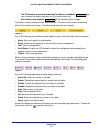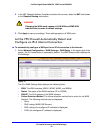
IPv4 and IPv6 Internet and WAN Settings
28
ProSafe Gigabit Quad WAN SSL VPN Firewall SRX5308
3. Configure the IPv6 tunnels. Enable 6to4 tunnels and configure ISATAP tunnels: See
Configure 6to4 Automatic Tunneling on
page 63 and Configure ISATAP Automatic
Tunneling on p
age 64.
4. (Op
tional) Configure Stateless IP/ICMP Translation (SIIT). Enable IPv6 devices that do
not have permanently assigned IPv4 addresses to communicate with IPv4-only devices:
See Configure Stateless IP/ICMP Translation on p
age 66.
5. (
Optional) Configure the WAN options. If required, change the factory default MTU size,
port speed, and MAC address of the VPN firewall: See Configure Advanced WAN Options
and Other Tasks on p
age 67. These are advanced features, and you usually do not need to
change the settings.
Configure the IPv4 Internet Connection and WAN Settings
• Configure the IPv4 WAN Mode
• Let the VPN Firewall Automatically Detect and Configure an IPv4 Internet Connection
• Manually Configure an IPv4 Internet Connection
• Configure Load Balancing or Auto-Rollover
• Configure Secondary WAN Addresses
• Configure Dynamic DNS
To set up your VPN firewall for secure IPv4 Internet connections, you need to determine the
IPv4
WAN mode (see the next section) and then configure the IPv4 Internet connection to
your ISP on the WAN port. The web management interface offers two connection
configuration options, discussed in the following sections:
• Let the VPN Firewall Automatically Detect and
Configure an IPv4 Internet Connection on
page 30
• Manually Configure an IPv4 Internet Connection on p
age 33
Configure the IPv4 WAN Mode
By default, IPv4 is supported and functions in NAT mode but can also function in classical
routing mode. IPv4 functions the same way in IPv4-only mode that it does in IPv4 / IPv6
mode. The latter mode adds IPv6 functionality (see Configure the IPv6 Routing Mode on
page 52).
Network Address Translation
Network Address Translation (NAT) allows all computers on your LAN to share a single public
Internet IP address. From the Internet, there is only a single device (the VPN firewall) and a
single IP address. Computers on your LAN can use any private IP address range, and these
IP addresses are not visible from the Internet.


















